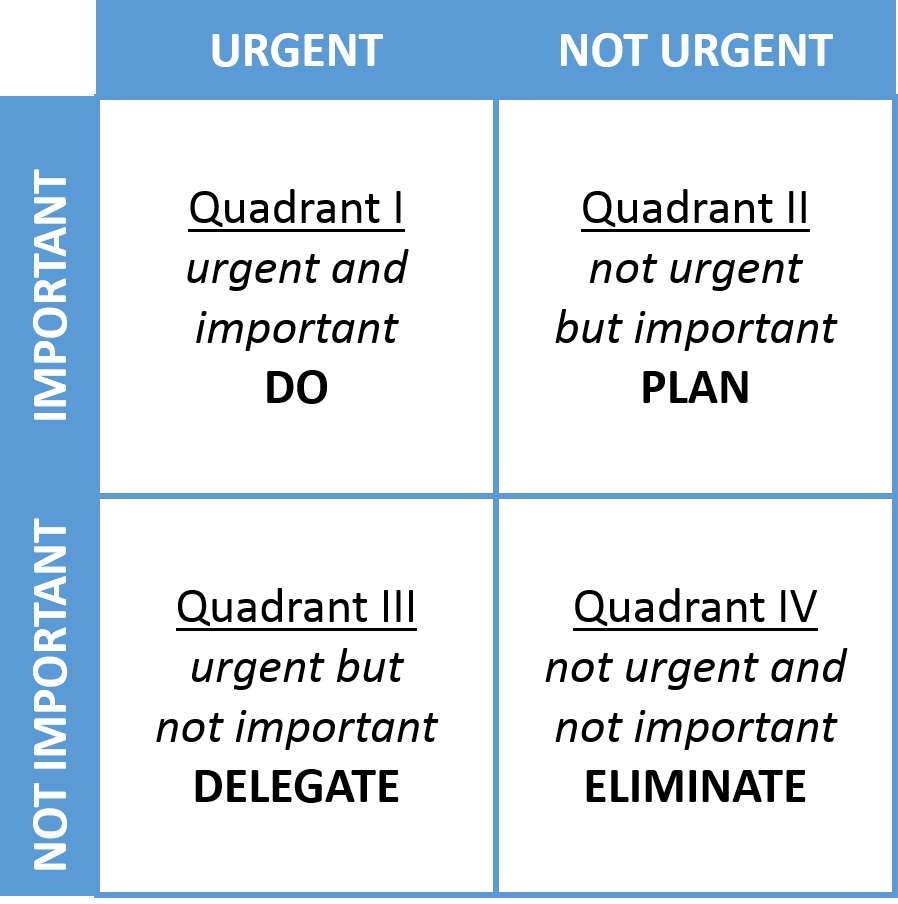No matter how hard we try, there will always be the same 24 hours in each day, which makes proper time management as important as ever. Our days are getting more filled, not less, with things to do and people we want to see. Whether you are a business owner, employee or just someone who wants to better manage your household schedule, the Covey Matrix of Time Management can help. Let’s take a look at the four quadrants of this incredible tool to help guide your day.
What Is Covey’s Matrix?
Better known as Covey’s Matrix, the four quadrant time management matrix is a framework for organizing all of your time, habits and productivity needs. Human nature dictates that we will likely prioritize our tasks and overlook others that are more trivial. Covey’s Matrix helps place our tasks into one of four “quadrants” to help you best manage your time. According to creator and writer Steven Covey, author of “The Seven Habits of Highly Effective People,” tasks are organized by one of two methods:

- Urgency: Tasks or responsibilities that require immediate attention or action. They are likely the tasks that have more critical deadlines and need to be addressed promptly. Failure to do so risks overall workplace performance.
- Importance: Tasks or responsibilities that have a high level of significance or are valuable for all of your time management goals. These should be activities that have a direct impact on any medium or long-term goals. They require more attention and are not something you can expect to accomplish in a few hours or a single day.
With those methods in mind, you can now break down each of the four quadrants into different properties to help you prioritize your tasks:
- Quadrant 1: Urgent and important
- Quadrant 2: Not urgent but important
- Quadrant 3: Urgent but not important
- Quadrant 4: Not urgent and not important
Quadrant One (Top Left)

Anything that falls into this first quadrant is something that would be recognized as a crisis, emergency, or an impending deadline. These are the first tasks you need to consider each morning in order to maintain your time management practices.
Any task here should be directly related to a time-sensitive goal or alleviating immediate risk to a project, deadline, or household task. This should be something like a family emergency brought on by an accident or finalizing a new client proposal that is set to be presented in a few hours/next day.
Quadrant Two (Top Right)
The second quadrant is most likely where people will be spending a good chunk of their time management. This not urgent but important box still requires a heavy focus on staying on a schedule and planning out your day to ensure you check off your to-do list. More than any other box, this quadrant requires a strong level of discipline to stay on track and identify what part of these important tasks you can control.

Like the first quadrant, this doesn’t all have to be work-related either, as a good personal example of the second quadrant is exercising or seeing friends and family. On the work side, it’s a good place to pitch new clients. Plan each of the tasks that fit in this box so you can stay on target to hit all of your long-term goals.
Quadrant Three (Bottom Left)
The urgent but not important bottom-left of the matrix is best reserved for anything that feels like it can be minimized. In fact, this box might even go as far as to say that these tasks can be eliminated altogether.

It’s within this box that you would put any task that doesn’t really contribute to your overall output or time management. Separately, you can also take tasks from this box and delegate them out to other members of your team, friends, family, etc. That’s especially true for meetings, as you should lose any meeting that feels like it can be handled through email or a quick phone call.
Quadrant Four (Bottom Right)
Whereas the third quadrant is all about stuff that can be lost, the fourth quadrant is more about things that are stuck with low priority. Nothing placed here should be important or urgent, nor should it have an immediate or even quickly approaching deadline. You may be tempted to call this quadrant box the home of time-wasters, like watching television or movies, but it does serve a purpose.

These are not tasks that are going to help you at work or make a presentation pitch go smoothly, but they will help you energize and get ready to tackle the items in quadrants one and two. Place anything here that is least likely to cause stress and has no time-sensitive goals. Want to spend time surfing Facebook or the Web? This is the box to add that to your schedule.
Final Thoughts
As you start to familiarize yourself with the four quadrants, it’s important to recognize where you should focus most of your energy. If managing your time is the most important factor for you, the second quadrant is the best place to put your focus. This will allow you to feel some pressure coming out of quadrant one, which is where you are most likely to group everything. By doing so, you would feel rushed, and your time management would get thrown right out the window.
Shifting some of those tasks into quadrant two will help you better manage critical understandings of important and urgent. The more time you spend inside the time management matrix, the more of an understanding you will have of how to best balance your time today, tomorrow and well into the future. If you’re looking to learn more, check out these time management books.

